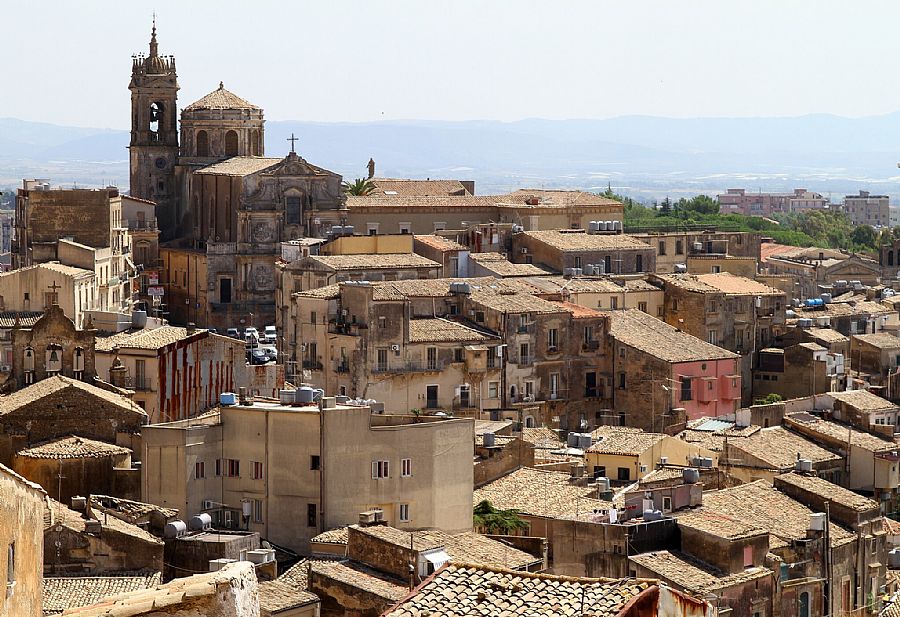Caltagirone

Amber colored and compacted on a hill above a plain, Caltagirone rests between Catania and Gela, and is considered part of the famous Val di Noto. It is technically part of the Catania metro area, though it sits 40 minutes from that provincial capital. It is closer to seaside Gela, and in reach of Ragusa and Modica, and Siracusa with its spectacular Greek temples, is just a little farther away than Catania. Caltagirone is included in the Baroque-built towns of the Val di Noto, named by UNESCO as a collective World Heritage Site, for having rebuilt in baroque style following an earthquake in 1693.
But beyond the baroque and honey-tinted architecture made of the tufa, the city is best known for its ceramics, a tradition that dates back centuries (and actually millennia!). In fact, excavations have shown that ceramics were already being produced here in the 10th century BC! Examples can be seen at the Museo Regionale della Ceramica. Of course, they can also be seen all around town, and not just in the ceramicists shops, but embedded in the buildings and public spaces. The town is quite well known for its long staircase, called the Scalinata di Santa Maria del Monte - with 142 steps, each one with ceramic embellishments on the front of it. It makes for dramatic photos and its not uncommon to find bridal couples having pictures taken there. Ornate vases, founts and other ceramics were all used in the baroque reconstructions. Today, you'll find colorful arrays of different items, but most notable are the "Moors heads" - ornamental vases in the shape of heads (men or women) with different decorations, hailing back to when the island was under the rule of the Moors. Other figures are featured as well, like shepherds, peasants and such. But much of the ceramics display the artistry of Sicily's fabrics and lacework designs. Under Arab rule, the town was calle Qal at al Gharum, meaning rock of the jars, for its works in clay. It become one of the islands most important centers of craftsmanship for the medium.
The Juesuits brought philosophy, law, medical studies and a hospital. There are churches, monasteries and many palazzi di view as you stroll around town. It had prosperity, order, teaching and a vibrant trade. Then the earthquake of 1693 brought everything to the ground. The reconstructions brought not only some of the new baroque style that is seen in the other Val di Noto towns but a vibrant resurgence of the ceramics crafts, as you can see today in public buildings, fountains, and palaces (a good example is the Galleria Luigi Sturzo, home to a theater) and the museum of ceramics, of course. There are many, many artisan shops around town, so you'll have an overload of colorful beauty, like a kaleidescope!
Don't miss the public gardens, the Diocesan museum, and the many art-filled churches. Just roaming around is a joy, as there is something to see at every turn! There are of course great wine bars, tempting pastry shops, excellent restaurants and trattorias, and winding streets so there's plenty to explore.
The famous staircase already mentioned features heavily in many celebrations. It gets lit up in July in Arab style for the feast of San Giacomo, and is bedecked by flowers, or illuminated in many ways for various festivities throughout the year.
Nearby towns like Piazza Armerina and the Villa Romana del Casale are archeologically well known along with archeological parks of Gela and Morgantina. Don't miss the hexagon town of Grammichele! Very interesting layout with a hexagonal piazza at its very core!
The beaches at Gela are only about a half-hour away. Most of southern Sicily is in reach, as is Catania.
Photo: Carlo Pelagalli, CC BY-SA 3.0 via Wikimedia Commons
Rent a holiday house in Caltagirone and travel like a local.

 Amalfi Coast
Amalfi Coast Sorrento Coast
Sorrento Coast Tuscany
Tuscany Cilento National Park
Cilento National Park Lake Como
Lake Como Rome and Latium
Rome and Latium Umbria
Umbria Capri and Ischia
Capri and Ischia Venice
Venice Puglia (Apulia)
Puglia (Apulia) Liguria
Liguria Sicily
Sicily Lake Maggiore
Lake Maggiore Lombardy
Lombardy Sardinia
Sardinia Lake Garda
Lake Garda Abruzzo and Marche
Abruzzo and Marche Calabria
Calabria

